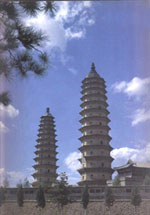The dynastic cycle, with long periods of prosperity  followed by periods of decline, rebellion & bloodshed, has long been considered the model for China's past. This cycle is no better highlighted than in the history of the Shanxi capital, Taiyuan, whose swings have affected the town/city since its inception.
The original town of Taiyuan was first settled over 2,500 years ago. Lying in the heart of Shanxi Province, this area was strategically vital, separating the troublesome north and northwest from the prosperous, stable lands to the south and southeast. As the town grew it was here that frequent battles were fought, and this is indicated by the 27 temples that were dedicated to the god of war. The first proper invasion of the area was in 200 BC by the Mongols, and the town was in and out of war until the Northern Wei Dynasty (386-534 AD) was established.
The town at this time entered a period of stability for a number of years. The Tang Dynasty (618-907 AD) saw the golden years in the city, as prosperity soared and infrastructure was vastly improved. Trade in silk and numerous other commodities hit an all time high and the town was well known as a stable post on the edges of Han Chinese control. The most interesting new product at this time was the imported grapes, that have been grown in this area ever since.
The following Five Dynasty Period (907-960 AD) saw some of the most turbulent times that the city has experienced, as various factions attempted to extend their influence of power. It was in 976AD that the city suffered its worst fate, being burnt to the ground by unhappy Song Dynasty forces.
Prosperity returned from the eleventh century, as the city became a great center for trade and industry. It was in this area, especially around the town of Pingyao, that the great financial institutions of China were founded. Basic stability continued up until the nineteenth century, towards the end of which the city emerged as a major economic powerhouse. The Boxer Rebellion (1898-1900), a Chinese faction's war against foreign oppression and the Qing Dynastic system, particularly affected the city, however. It was here that all the resident foreigners were killed, possibly in part because of their role in the extraction of the mineral resources in the province.
The Republic of China (1912-1949) that followed, saw the region's most warlike warlord, Yan Xishan, take Taiyuan as his capital. Although only mildly Republican at heart, the warlord carried on with the economic and industrial growth that had continued (with foreign help despite the Boxer massacre). This growth and industrial concentration was a theme that continued after the Communist succession (est.1950), and this has changed the face of Taiyuan.
The city nowadays, perched in the heart of Shanxi Province, is generally considered just a stopover for those heading south to the ancient imperial capital, Xi'an, or those trecking north to the grottoes/hanging monastery near Datong and the sacred Buddhist mountain of Wutaishan. Like much of the cities and towns in this region, Taiyuan is heavily polluted, by coal particles, from the abundant coal reserves, and the smog from various factories and homes. The ancient architecture and temples that once filled the town are now hard to come across, although there are a few sights out of town were these can still be found. |
